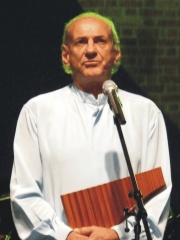
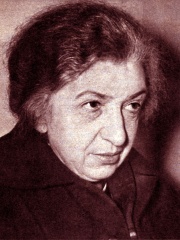
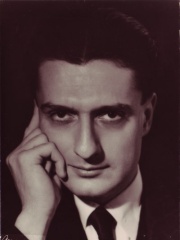
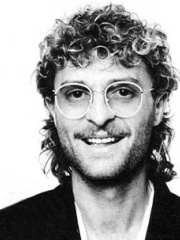

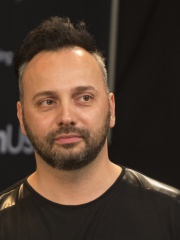
The Most Famous
MUSICIANS from Romania
Top 7
The following people are considered by Pantheon to be the most legendary Romanian Musicians of all time. This list of famous Romanian Musicians is sorted by HPI (Historical Popularity Index), a metric that aggregates information on a biography's online popularity.

1. Gheorghe Zamfir (b. 1941)
With an HPI of 69.05, Gheorghe Zamfir is the most famous Romanian Musician. His biography has been translated into 35 different languages on wikipedia.
Gheorghe Zamfir (Romanian pronunciation: [ˈɡe̯orɡe zamˈfir] ; born April 6, 1941) is a Romanian nai (pan flute) musician. Zamfir is known for playing an expanded version of normally 20-pipe nai, with 22, 25, 28 or even 30 pipes, to increase its range, and obtaining as many as eight overtones (additional to the fundamental tone) from each pipe by changing his embouchure. He is known as "The Master of the Pan Flute".

2. Clara Haskil (1895 - 1960)
With an HPI of 68.12, Clara Haskil is the 2nd most famous Romanian Musician. Her biography has been translated into 28 different languages.
Clara Haskil (7 January 1895 – 7 December 1960) was a Romanian classical pianist, renowned as an interpreter of the classical and early romantic repertoire. She was particularly noted for her performances and recordings of Mozart. She was also a noted interpreter of Beethoven, Schumann, and Scarlatti.

3. Dinu Lipatti (1917 - 1950)
With an HPI of 67.00, Dinu Lipatti is the 3rd most famous Romanian Musician. His biography has been translated into 28 different languages.
Constantin "Dinu" Lipatti (Romanian pronunciation: [ˈdinu liˈpati] ; 1 April [O.S. 19 March] 1917 – 2 December 1950) was a Romanian classical pianist and composer whose career was cut short by his death from effects related to Hodgkin's disease at age 33. He was elected posthumously to the Romanian Academy. He composed few works, all of which demonstrated a strong influence from Hungarian composer Béla Bartok. A relentless perfectionist, Lipatti often prepared many years for major performances, such as four years for Beethoven's Piano Concerto No. 5 and three for Tchaikovsky's Piano Concerto No. 1. He left a small number of recordings, and they are well-regarded, particularly that of Alborada del gracioso from Ravel's Miroirs suite. In his short lifetime he was highly acclaimed by prominent musical figures of the 20th century, including Yehudi Menuhin, Alfred Cortot, Nadia Boulanger, and Francis Poulenc.

4. Michael Cretu (b. 1957)
With an HPI of 66.39, Michael Cretu is the 4th most famous Romanian Musician. His biography has been translated into 32 different languages.
Michael Cretu (Romanian: Mihai Crețu, pronounced [miˈhaj ˈkretsu]; born 18 May 1957) is a Romanian-German musician, singer, songwriter, composer, and record producer. He gained worldwide fame as the founder and musician behind the musical project Enigma, which he formed in 1990. Cretu began his music career in 1976 as a solo artist, releasing three studio albums as well as writing and producing albums for his then-wife, German pop singer Sandra. He also worked with other artists through the 1980s, including Peter Cornelius, Hubert Kah, and Mike Oldfield. Cretu was sometimes identified as "Curly" or "Curly M.C.", in reference to his curly hair and creț meaning "curly" in Romanian. He scored an unexpected worldwide commercial hit with the debut Enigma album, MCMXC a.D. (1990), helped by its lead single, "Sadeness (Part I)". The project's most recent album is 2016's The Fall of a Rebel Angel, its eighth overall. Enigma has sold an estimated 70 million albums worldwide, and Cretu's produced recordings have sold 100 million copies.
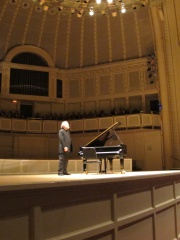
5. Radu Lupu (1945 - 2022)
With an HPI of 64.39, Radu Lupu is the 5th most famous Romanian Musician. His biography has been translated into 28 different languages.
Radu Lupu (30 November 1945 – 17 April 2022) was a Romanian pianist. He was widely recognized as one of the greatest pianists of his time. Born in Galați, Romania, Lupu began studying piano at the age of six. Two of his major piano teachers were Florica Musicescu, who also taught Dinu Lipatti, and Heinrich Neuhaus, who also taught Sviatoslav Richter and Emil Gilels. From 1966 to 1969, he won three of the world's most prestigious piano competitions: the Van Cliburn International Piano Competition (1966), the George Enescu International Piano Competition (1967), and the Leeds International Pianoforte Competition (1969). These victories launched Lupu's international career, and he appeared with all of the major orchestras and at all of the major festivals and music capitals of the world. From 1970 to 1993, Lupu made over 20 recordings for Decca Records. His solo recordings, which have received considerable acclaim, include works by Beethoven, Brahms, Grieg, Mozart, Schubert, and Schumann, including all of Beethoven's piano concertos, five piano sonatas and other solo works; the Grieg and Schumann piano concertos, as well as three major solo works of Schumann; nine piano sonatas, Impromptus and Moments musicaux of Schubert; various major solo works and the first piano concerto of Brahms; and two piano concertos of Mozart. His chamber music recordings for Decca include all of Mozart's sonatas for violin and piano with Szymon Goldberg; the violin sonatas of Debussy and Franck with Kyung Wha Chung; and various works by Schubert for violin and piano with Goldberg. He additionally recorded works of Mozart and Schubert for piano four-hands and two pianos with Murray Perahia for CBS Masterworks, Schubert songs with Barbara Hendricks for EMI, and works by Schubert for piano four-hands with Daniel Barenboim for Teldec. In addition, Lupu is also noted for his performances of Bartók, Debussy, Enescu, and Janáček, among other composers. Lupu was nominated for two Grammy Awards, winning one in 1996 for an album of two Schubert piano sonatas. In 1995, Lupu also won an Edison Award for a disc of three major piano works of Schumann. Other awards won by Lupu include the Franco Abbiati Prize in 1989 and 2006, and the 2006 Premio Internazionale Arturo Benedetti Michelangeli award.

6. Edward Maya (b. 1986)
With an HPI of 48.45, Edward Maya is the 6th most famous Romanian Musician. His biography has been translated into 38 different languages.
Eduard Marian Ilie (Romanian pronunciation: [ˈedu.ard mariˈan iˈli.e]; born 29 June 1986), better known by his stage name Edward Maya, is a Romanian musician, record producer, DJ and songwriter. He is known for his 2009 smash hit single "Stereo Love".

7. Ovidiu Cernăuțeanu (b. 1974)
With an HPI of 48.17, Ovidiu Cernăuțeanu is the 7th most famous Romanian Musician. His biography has been translated into 26 different languages.
Ovidiu Cernăuțeanu (Romanian pronunciation: [oˈvidju tʃernə.uˈtse̯anu]; born 23 August 1974), also known by his stage names Ovi Martin, Ovi Jacobsen, or simply Ovi, is a Romanian singer and songwriter. After being raised in Botoșani, he moved to Norway in 1995. He rose to fame in Norway in 2006 when he first took part in the Melodi Grand Prix 2006 with the song "The Better Side of Me" where he did not qualify to the final. The next year he was a finalist of the Melodi Grand Prix 2009 with the song "Seven Seconds" but lost to Alexander Rybak. In 2010 he participated in the Selecția Națională 2010 for Romania alongside duet partner Paula Seling. They won with the song "Playing with Fire" with which they represented Romania in the Eurovision Song Contest 2010. They qualified for the grand final where they took the third position, only behind winner Germany and runner-up Turkey. After Eurovision, Ovi released a new duet with Seling; "We Got Something". In 2012 he was back in the Melodi Grand Prix 2012 this time as a songwriter along with Thomas G:son and Tommy Berre for the song "High on Love" as performed by Reidun Sæther. The song qualified for the final. Apart from the European recognition, Ovi has also entered several music charts with songs like "Seven Seconds" (2009), "Playing with Fire" (2010) or "We Got Something" (2011) – the latter two are featuring Paula Seling. He is also the Popularity Award winner of the 2009 Golden Stag Festival in Romania. In 2014 he returned to Eurovision Song Contest 2014 together with duet partner Paula Seling when they participated for Romania with the song "Miracle". The same year Ovi co-wrote the song She's After My Piano for the group 2 Fabiola who participated in the Belgium national selection for Eurovision Song Contest 2014. The song did not win in Belgium but became a major hit for 2 Fabiola. Later Ovi and Paula Seling recorded their own version of the song for Ovi's album A Bit of Pop Won't Hurt Anyone, 5 May 2014 (daWorks).
People
Pantheon has 7 people classified as Romanian musicians born between 1895 and 1986. Of these 7, 4 (57.14%) of them are still alive today. The most famous living Romanian musicians include Gheorghe Zamfir, Michael Cretu, and Edward Maya. The most famous deceased Romanian musicians include Clara Haskil, Dinu Lipatti, and Radu Lupu.
Living Romanian Musicians
Go to all RankingsGheorghe Zamfir
1941 - Present
HPI: 69.05
Michael Cretu
1957 - Present
HPI: 66.39
Edward Maya
1986 - Present
HPI: 48.45
Ovidiu Cernăuțeanu
1974 - Present
HPI: 48.17

